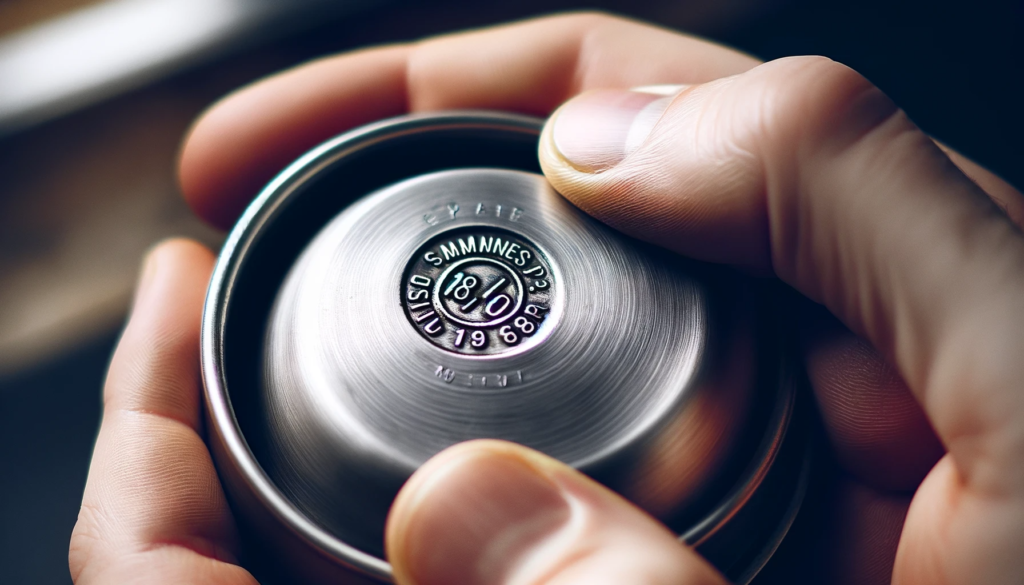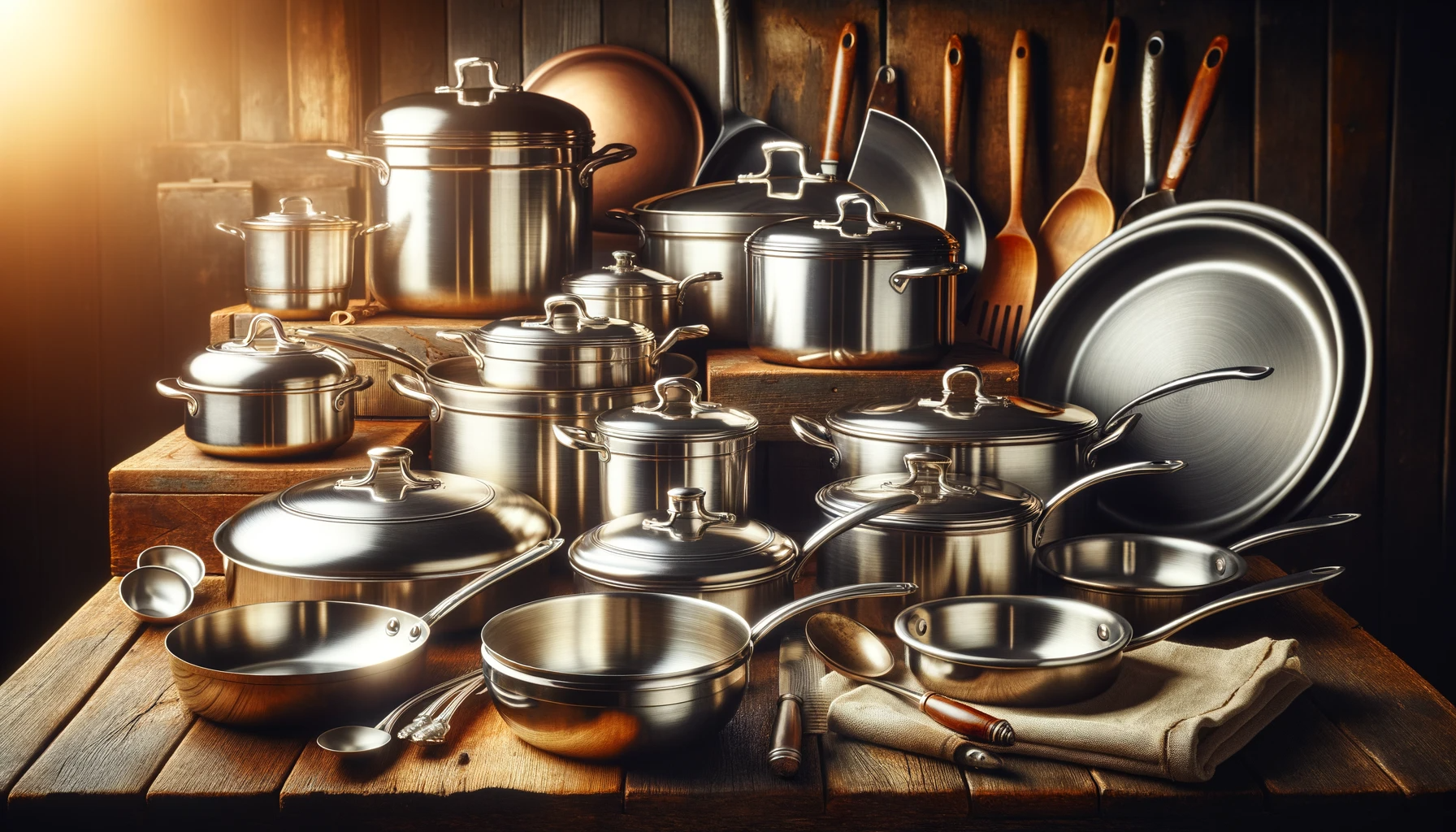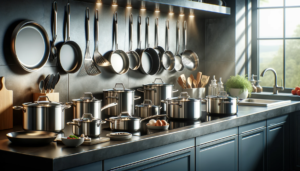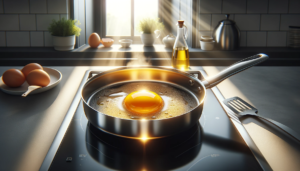Shopping for vintage stainless steel cookware can be daunting if you don’t know what to look for.
From examining obscure stamps to watching out for clever counterfeits, there’s a lot to consider beyond just snatching up those shiny pots and pans.
Understanding key evaluative criteria like steel grades, construction techniques, brand reputations, specialty use cases, and safety standards allows you to zero in on quality vintage pieces built to perform.
Let’s dive in to what details veteran collectors use to uncover vintage cookware gems…
What to Look for When Buying Vintage Stainless Steel Cookware?
When buying vintage stainless steel cookware, the key things to evaluate are the grade of stainless steel used, how the cookware is constructed, the current condition of the pieces, the reputation of the brand, the styles/specialization of the cookware, and whether there are any safety issues to be aware of.
In a nutshell, you want to look for 18/10 grade stainless from reputable brands like All-Clad or lesser known names like Viking or Magnalite.
Check that pots and pans have durable encapsulated bottoms and consistent, high-quality construction without damage.
Ensure any safety issues from past eras have been addressed as well.
We will explore all of these factors more in detail throughout this guide.
Check the Grade of Stainless Steel

Stainless steel cookware is made by combining steel with elements like chromium, nickel and molybdenum.
The grade of stainless steel refers to the exact amounts of these additional elements present in the metal.
There are a few common grades used in cookware that you may come across when shopping for vintage pieces.
One is 18/8 stainless steel, meaning it contains 18 percent chromium and 8 percent nickel.
18/10 stainless steel contains 18 percent chromium and 10 percent nickel.
There is also 18/0 stainless steel with 18 percent chromium and no nickel content.
For cookware purposes, you generally want a higher nickel content like 18/10 stainless steel.
The nickel gives the steel enhanced corrosion resistance compared to lower nickel grades.
This allows the cookware to better withstand exposure to acids, heat, water and the general wear and tear of kitchen use over time.
The higher 10 percent nickel content also makes vintage 18/10 stainless steel cookware more durable in terms of resisting dents and bends.
When assessing the grade of vintage stainless steel cookware you come across, start by looking at any stamps or markings on the bottom or sides of the pan.
Some manufacturers will stamp the full grade designation like 18/10 directly onto pieces.
Other times, you may just see a number like 430 or 304 rather than a percentage.
These numbers actually directly correlate to standard grades of stainless steel.
For example, 304 stainless steel contains 18-20 percent chromium and 8-10 percent nickel, putting it in the 18/10 category.
Examine the Construction

In addition to the grade of stainless steel used, you also want to consider the construction of vintage cookware when assessing quality and durability.
One aspect to look for is whether the cookware uses layered construction versus clad construction.
Layered construction sandwiches a conductive metal core like aluminum or copper between two layers of stainless steel.
This allows for efficient heat distribution while taking advantage of stainless steel’s durability on the outer layers.
Clad cookware has the stainless steel and conductive metal bonded together on one or both sides of the pan.
While clad construction can also deliver excellent heating properties, it can be more likely to separate over years of cooking compared to a layered pan.
Another construction factor to examine is the cookware’s bottom.
Higher end vintage stainless steel cookware often has a bottom made of a single thick encapsulated piece of conductive metal, usually aluminum or copper.
Cheaper cookware may just have a thin disc of conductive material in between two stainless layers on the bottom rather than running up partially encapsulated up the sides.
An evenly spread out, integrated bottom tends to allow for the most consistent heating.
You also generally want to avoid very thin stainless steel pans where you can visibly see a lot of movement or impression when you press on the sides.
While thin stainless will be lighter in weight, it is more prone to warping and denting over time.
Assess Condition of Cookware

When dealing with vintage cookware that may be decades old, having a careful eye to assess the condition is important.
Start by looking over the entire pan or pot to check for dents, excessive scratches, warping and other damage.
Small dents and surface scratches that do not impact performance can often be overlooked.
However, more severe dents along the bottom or badly bent rims are red flags.
Check to see if there is any corrosion or rust present around rivets, welds and handles.
This can happen if pieces have been improperly stored and requires extensive restoration work.
You also want to take a look at the lid and handles when evaluating condition.
Bakelite and wood handles can crack and degrade over many years of use.
Glass lids are prone to scratches and chips if not stored properly.
While replacing handles and lids can restore functionality, this does diminish some vintage appeal.
Check that handles and lids sit securely where attached to the main pan body.
If properly cared for, vintage stainless steel cookware has the durability to last indefinitely.
But it pays to thoroughly examine all pieces for areas of concern to get a sense of whether much restoration work would be required before it can perform as expected.
Review Brand Reputations

Higher-end vintage cookware brands like All-Clad, Calphalon and Cuisinart have built strong reputations over decades when it comes to quality and performance.
Coming across sought after vintage pieces from these brands provides some reassurance.
That said, always do additional research before purchasing.
There are also plenty of lesser known vintage brands that produced excellent stainless steel cookware that holds up exceptionally well over time.
Brands like Viking, Chantal and Magnalite have developed cult followings among vintage cookware enthusiasts while maintaining lower name recognition.
When assessing vintage brands, it helps to consult online collector forums, reference guides and general customer reviews for that manufacturer.
Confirm details like years of operation, manufacturing standards, and materials used.
One word of warning is to beware of potential counterfeit or “tribute” pieces that copy the look of established brands.
For example, the high desirability of All-Clad cookware has led to imitation brands producing lookalike cookware to sell off the prestigious name.
So make sure to carefully research markings and quality before making assumptions on vintage brand reputation alone.
Consider Cookware Specialization
Vintage stainless steel cookware encompasses a wide range of pot and pan styles designed for different cooking methods.
Consider building a collection of complementary pieces rather than randomly buying up vintage items.
Useful core pieces include various sized pots, skillets, saucepans, and stock pots.
You may also come across more specialized vintage items like double boilers, griddles and roasting pans.
Whatever your intended cooking style and go-to recipes, seek out vintage stainless cookware tailored for those needs.
For example, those who cook a lot of sauces would want to source vintage saucepans ranging up to 4 quarts.
Or if baking is more your specialty, keep an eye out for sets of vintage mixing bowls.
Skillet and sauté pan sizes can range widely from 8 inches on up to 14 inches to allow cooking everything from a single egg to a large batch of fajitas.
Build up a diversity of pieces that aligns with your range of recipes.
And do not forget lids! Make sure to acquire properly fitting lids for all pots and pans you purchase.
Nothing more frustrating than coming home excited to cook with your vintage finds only to realize mismatched lids.
Check for Safety Standards

With vintage cookware, you are dealing with pieces manufactured before more stringent modern safety standards were put in place.
For example, lead was once common in components like cookware handles before health concerns led to restrictions.
And materials like ceramic and enamel coatings have evolved over time as durability expectations increased.
While the odds of coming across pieces with legit safety issues are low, it is still worth doing a spot check.
Look into whether any toxic materials like lead may have been present in old handles or helper handles based on brand and era of manufacturing.
Be extra diligent if pieces have any chips or cracking around these points of contact.
Determine if the cookware predates the advent of certification standards for things like food safe coatings.
Even without certifications, quality vintage manufacturers generally took great pride in creating durable and safe products designed to last through generations of use.
But confirming this can provide peace of mind.
You can also do spot safety checks around areas like handles.
Make sure any rivets or welds securing handles appear sturdy with no loosening or gaps.
Confirm handles are firmly attached and sit straight rather than wobbly.
Do a few test runs washing, heating and using the cookware while keeping an eye out for anything that seems unsafe or not securely attached.
In most cases, the exceptional workmanship and materials used in vintage stainless steel cookware matches up safety-wise to modern pieces.
But it never hurts to be fully aware of any potential red flags to identify and address.
Conclusion
Searching out quality vintage stainless steel cookware takes a bit more effort compared to just grabbing a set off the shelves at a big box store.
But the expanded search is well worth it for cookware with superior performance, craftsmanship and lifespan.
Keep an eye out at secondhand stores, antique shops, estate sales and online auctions for great vintage scores.
Whether replacing every pan in your kitchen or just supplementing with specialized pieces, using this guide to assess stainless steel grades, construction quality, brand reputation and safety can help yield amazing vintage finds your family will enjoy for generations.



